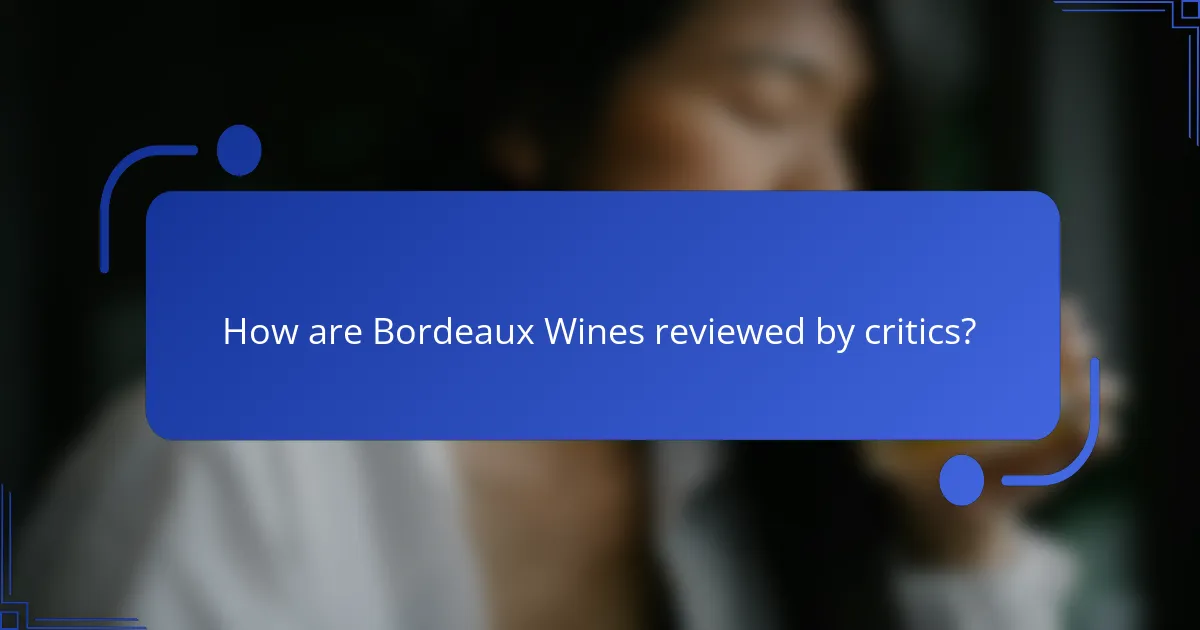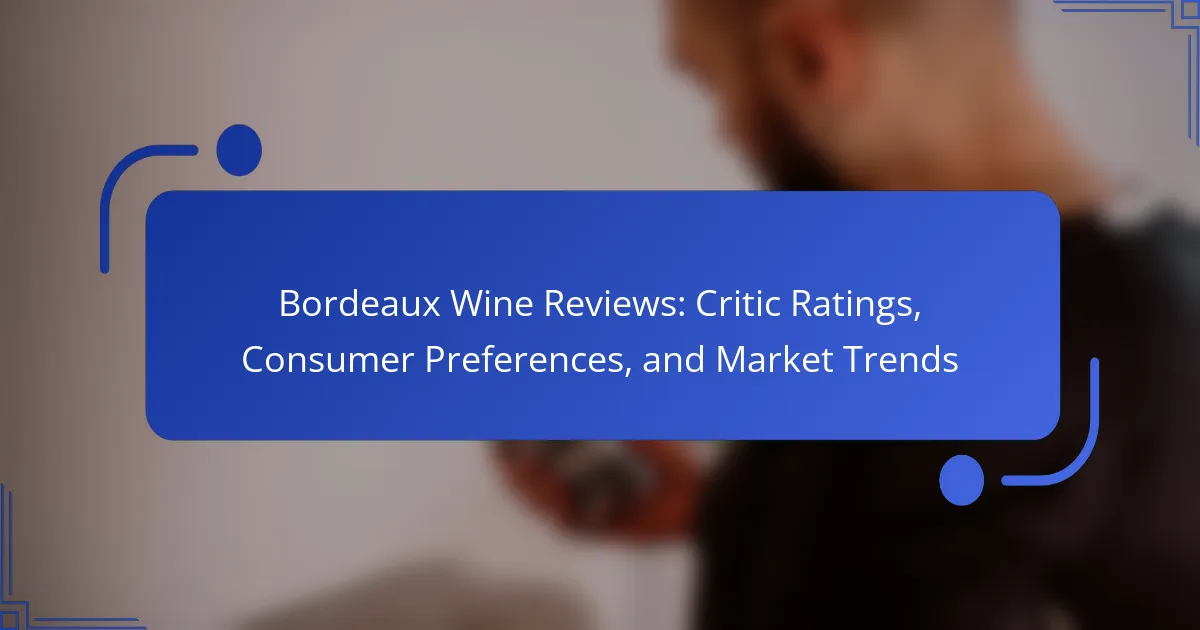
What are Bordeaux Wines?
Bordeaux wines are wines produced in the Bordeaux region of France. This area is known for its diverse terroirs and grape varieties. Bordeaux wines primarily consist of red, white, and rosé types. The main grape varieties used in red Bordeaux wines include Merlot, Cabernet Sauvignon, and Cabernet Franc. White Bordeaux wines typically feature Sauvignon Blanc, Sémillon, and Muscadelle. Bordeaux wines are often characterized by their complexity and aging potential. The region has a long history of viticulture, dating back to Roman times. Bordeaux wines are classified into several categories, including AOC (Appellation d’Origine Contrôlée) designations. The most prestigious Bordeaux wines come from classified growths in the Médoc and Saint-Émilion regions.
How are Bordeaux Wines classified?
Bordeaux wines are classified primarily through a system known as the Bordeaux Wine Official Classification of 1855. This classification ranks wines based on their quality and reputation. The classification includes five tiers, known as crus, with Premier Cru being the highest. It primarily focuses on red wines from the Médoc region. Each château is rated based on historical performance and market price. The classification remains influential today, guiding consumers and investors. Additional classifications exist for specific regions, such as Saint-Émilion and Graves. These classifications also assess quality but may use different criteria. The classifications reflect both tradition and market dynamics in Bordeaux wine.
What are the different types of Bordeaux Wines?
Bordeaux wines can be categorized into several types. The primary categories include red, white, and rosé wines. Red Bordeaux wines are typically blends of Cabernet Sauvignon, Merlot, and Cabernet Franc. Notable examples include wines from the Left Bank and Right Bank regions. White Bordeaux wines mainly consist of Sauvignon Blanc and Sémillon. These wines can be dry or sweet, with Sauternes being a famous sweet white example. Rosé Bordeaux wines are made from red grape varieties, offering a lighter option. Each type reflects the unique terroir of the Bordeaux region.
What regions contribute to Bordeaux’s wine production?
Bordeaux’s wine production is primarily contributed by several key regions. The most notable regions include the Médoc, Saint-Émilion, and Pomerol. The Médoc is known for its Cabernet Sauvignon-based wines. Saint-Émilion is recognized for its Merlot-dominant blends. Pomerol produces renowned wines, particularly from the Merlot grape. Other contributing areas are Graves, Sauternes, and Entre-Deux-Mers. Each of these regions has distinct terroirs that influence the flavor profiles of the wines produced. Bordeaux’s classification system further highlights the quality and prestige of wines from these regions.
What makes Bordeaux Wines unique?
Bordeaux wines are unique due to their distinct terroir and blending practices. The region’s diverse microclimates contribute to the complexity of flavors. Bordeaux is renowned for its specific grape varieties, including Cabernet Sauvignon, Merlot, and Cabernet Franc. These grapes are often blended to achieve balance and depth. The aging process in oak barrels adds additional layers of flavor. Bordeaux wines are also categorized by quality classifications, such as the 1855 Classification. This historical context enhances their prestige and market value. The wines’ aging potential is another unique feature, with some improving over decades. These elements collectively define the uniqueness of Bordeaux wines.
How do climate and terroir influence Bordeaux Wines?
Climate and terroir significantly influence Bordeaux wines by shaping their flavor profiles and quality. Bordeaux’s climate is characterized by a maritime influence, with moderate temperatures and rainfall. This climate allows for a long growing season, which is essential for grape ripening. Terroir, which includes soil composition, topography, and microclimates, also plays a critical role. The diverse soils in Bordeaux, such as gravel, clay, and limestone, contribute unique characteristics to the grapes. For instance, gravel soils are known for producing high-quality Cabernet Sauvignon. Research shows that the interaction between climate and terroir results in distinct variations in wine styles from different Bordeaux regions. These factors combined create the complexity and richness that Bordeaux wines are renowned for.
What grape varieties are predominant in Bordeaux Wines?
The predominant grape varieties in Bordeaux wines are Cabernet Sauvignon, Merlot, and Cabernet Franc. Cabernet Sauvignon is known for its rich flavor and aging potential. Merlot offers a softer, fruitier profile, making it widely popular. Cabernet Franc adds complexity and aromatic qualities to blends. These three varieties are essential in the Bordeaux blend, which is a hallmark of the region. Bordeaux wines often showcase a balance of these grapes, contributing to their renowned quality. The region’s climate and soil types support the growth of these varieties, enhancing their characteristics.

How are Bordeaux Wines reviewed by critics?
Bordeaux wines are reviewed by critics through a systematic evaluation of their characteristics. Critics assess attributes such as aroma, flavor, body, and finish. They often use a point system to quantify their ratings. Reviews typically include tasting notes that describe the wine’s profile. Critics may also consider the wine’s vintage and producer reputation. Publications like Wine Spectator and Robert Parker’s Wine Advocate are influential in this process. These reviews guide consumers and impact market trends. High ratings can significantly increase a wine’s market value.
What criteria do critics use to rate Bordeaux Wines?
Critics use several criteria to rate Bordeaux wines. These criteria include aroma, flavor, balance, structure, and finish. Aroma assesses the complexity and intensity of scents. Flavor evaluates the richness and depth of taste. Balance considers the harmony between acidity, tannins, and sweetness. Structure examines the wine’s body and mouthfeel. Finish looks at the length and quality of aftertaste. Critics often refer to established rating systems, such as the 100-point scale. This scale provides a standardized way to communicate quality. Additionally, vintage and terroir influence ratings significantly. Critics may also consider the winemaking process and aging potential.
How do tasting notes impact critic ratings?
Tasting notes significantly influence critic ratings by providing a detailed sensory evaluation of the wine. Critics use these notes to articulate the wine’s flavor profile, aroma, and texture. This descriptive analysis helps establish a wine’s quality and complexity. For instance, tasting notes that highlight unique flavors can elevate a wine’s perceived value. Research indicates that wines with more detailed and favorable tasting notes often receive higher scores. A study published in the Journal of Wine Economics found that wines described as having “rich fruit flavors” scored significantly higher than those with vague descriptors. Thus, tasting notes serve as a critical tool in shaping critic perceptions and ratings.
What are some notable critic organizations for Bordeaux Wines?
Notable critic organizations for Bordeaux wines include the Wine Spectator, Robert Parker’s Wine Advocate, and Decanter. Wine Spectator provides comprehensive reviews and ratings for Bordeaux wines, influencing consumer choices. Robert Parker’s Wine Advocate is renowned for its detailed assessments and scoring system, particularly for Bordeaux vintages. Decanter offers expert opinions and tasting notes, catering to both enthusiasts and collectors. These organizations are influential in shaping the perception and market value of Bordeaux wines globally.
How do consumer preferences shape Bordeaux Wine reviews?
Consumer preferences significantly influence Bordeaux Wine reviews. Reviews often reflect the tastes and expectations of consumers. When consumers favor certain flavor profiles, critics may highlight those attributes in their evaluations. Popularity of specific vintages can lead to increased attention in reviews. Additionally, consumer feedback shapes the narrative around wine quality. This can affect both critic ratings and market trends. For example, wines that align with consumer preferences may receive higher ratings. Conversely, wines that do not meet these preferences may be rated lower. Thus, consumer preferences play a crucial role in shaping the perception of Bordeaux wines.
What trends are observed in consumer preferences for Bordeaux Wines?
Consumers are increasingly favoring organic and biodynamic Bordeaux wines. This shift is driven by a growing awareness of health and environmental concerns. A survey by Wine Intelligence in 2022 indicated that 35% of consumers prefer wines produced with sustainable practices. Additionally, younger consumers show a preference for lighter, fruit-forward styles of Bordeaux. This contrasts with traditional, heavier Bordeaux blends that were popular in previous decades. The rise of online wine sales has also influenced consumer preferences. More consumers are seeking convenience and variety through digital platforms. Overall, trends indicate a move toward sustainability, lighter styles, and online purchasing in the Bordeaux wine market.
How do price and quality affect consumer choices?
Price and quality significantly influence consumer choices in the wine market. Consumers often associate higher prices with better quality. A study by the University of California found that consumers are willing to pay up to 20% more for wines rated highly by critics. This indicates that perceived quality can drive purchasing decisions. Additionally, consumers may avoid lower-priced wines due to concerns about quality. Research published in the Journal of Wine Economics shows that price sensitivity varies among consumers. Some prioritize quality over price, while others focus on affordability. Ultimately, both factors interact to shape consumer preferences and buying behavior in the Bordeaux wine market.

What are the current market trends for Bordeaux Wines?
Current market trends for Bordeaux wines indicate a rising interest in sustainable and organic production methods. Consumers are increasingly prioritizing environmentally friendly practices. There is also a growing demand for Bordeaux wines in emerging markets, particularly in Asia. Sales data shows a significant increase in exports to countries like China and Japan. Additionally, premium Bordeaux wines are experiencing higher valuations at auctions. This trend reflects a shift towards luxury consumption among affluent buyers. Furthermore, younger consumers are showing interest in Bordeaux through social media and digital marketing. This engagement is reshaping marketing strategies within the industry. Overall, the Bordeaux wine market is adapting to changing consumer preferences and global economic conditions.
How is the demand for Bordeaux Wines changing globally?
The demand for Bordeaux wines is experiencing a shift globally. Recent trends indicate a growing interest in premium wines, including Bordeaux. Emerging markets, particularly in Asia, are contributing to this increased demand. For example, exports of Bordeaux wines to China rose by 30% in 2022. Additionally, younger consumers are showing a preference for Bordeaux wines, driving sales growth. This trend is supported by a rise in wine tourism in the Bordeaux region. Overall, the global market for Bordeaux wines is evolving, with an emphasis on quality and new consumer demographics.
What factors are influencing the pricing of Bordeaux Wines?
The pricing of Bordeaux wines is influenced by several key factors. First, the quality of the vintage plays a significant role. Exceptional years yield higher prices due to limited supply and increased demand. Second, the reputation of the winery affects pricing. Renowned châteaux command premium prices based on their historical prestige. Third, market demand significantly impacts pricing. Growing interest from international buyers can drive prices up. Fourth, critic ratings and reviews influence consumer perceptions and willingness to pay. High scores from respected critics can lead to price increases. Lastly, economic conditions and currency fluctuations also affect pricing. Changes in the global economy can impact purchasing power and investment in fine wines.
How do vintage years affect market trends for Bordeaux Wines?
Vintage years significantly influence market trends for Bordeaux wines. High-quality vintages typically lead to increased demand and higher prices. For example, the 2005 and 2010 vintages are widely regarded as exceptional. This reputation drives collectors and investors to seek these wines. Conversely, lower-quality vintages may result in decreased interest and lower market values. The 2013 vintage, for instance, faced challenges due to poor weather conditions. Additionally, historical sales data shows that top vintages often appreciate in value over time. This trend reflects consumer preferences for quality and rarity in Bordeaux wines.
What insights can be drawn from Bordeaux Wine reviews and market trends?
Bordeaux Wine reviews reveal consumer preferences and market trends. Reviews often highlight specific vintages and producers that receive high ratings. For instance, the 2015 vintage has been praised for its quality and aging potential. Market trends indicate a growing interest in organic and biodynamic Bordeaux wines. Sales data shows that wines with high critic ratings tend to have increased demand. Additionally, pricing trends reflect that top-rated wines command higher prices. The Bordeaux market is also influenced by global economic conditions and consumer behavior. Overall, reviews and market analysis provide valuable insights into the evolving landscape of Bordeaux wines.
How can consumers use reviews to make informed purchasing decisions?
Consumers can use reviews to make informed purchasing decisions by analyzing ratings and feedback. Reviews provide insights into product quality and performance. For Bordeaux wine, expert critic ratings often reflect the wine’s characteristics and market value. Consumer preferences highlighted in reviews can reveal trends in taste and quality. Research indicates that 79% of consumers trust online reviews as much as personal recommendations. This trust can significantly influence buying choices. Additionally, reading multiple reviews helps consumers identify consistent themes and potential issues. By comparing expert and consumer opinions, buyers can make well-rounded decisions.
What best practices should consumers follow when selecting Bordeaux Wines?
Consumers should follow specific best practices when selecting Bordeaux wines. First, they should consider the wine’s vintage, as certain years yield better quality due to climatic conditions. Second, understanding the Bordeaux classification system is essential. This system ranks wines based on quality and reputation. Third, consumers should assess the producer’s reputation. Well-known châteaux often guarantee higher quality. Fourth, tasting notes and reviews from critics can provide valuable insights. Many Bordeaux wines are rated by established wine critics. Fifth, examining the wine’s blend is important. Bordeaux wines typically consist of Merlot, Cabernet Sauvignon, and Cabernet Franc. Lastly, consumers should consider their own taste preferences. Personal preference plays a significant role in wine enjoyment. Following these practices can enhance the selection process for Bordeaux wines.
Bordeaux wine is the primary entity of this article, focusing on its reviews, critic ratings, consumer preferences, and market trends. The article details the classification of Bordeaux wines, including the influential Bordeaux Wine Official Classification of 1855, and explores the predominant grape varieties and regions contributing to their production. It also examines how climate and terroir affect wine quality, the impact of critic reviews on consumer choices, and current market trends emphasizing sustainability and changing consumer demographics. Insights from recent sales data and tasting notes further inform the evolving landscape of Bordeaux wines.
